Assessment 2: MCK Test and Personal Numeracy Portfolio Analysis
VerifiedAdded on 2020/04/15
|20
|5521
|471
Homework Assignment
AI Summary
This assignment presents an analysis of a numeracy portfolio, focusing on fractions, decimals, and multiplicative thinking. It includes multiple-choice questions designed to assess student understanding of fraction addition, calculation of fractions of quantities, and the conversion between fractions, decimals, and percentages. The assignment also examines a diagnostic interview, evaluating students' ability to compare and order fractions, place them on a number line, and explain their reasoning. Furthermore, the paper explores the concept of multiplicative thinking, emphasizing its importance in mathematics education and providing strategies for enhancing students' understanding of multiplication and division. The content is aligned with the Australian Curriculum and provides insights into common misconceptions and effective teaching methods. The assignment aims to improve content knowledge and effective teaching skills by looking at the different contents of mathematics from the various outlooks of the main ideas in mathematics especially the numbers.
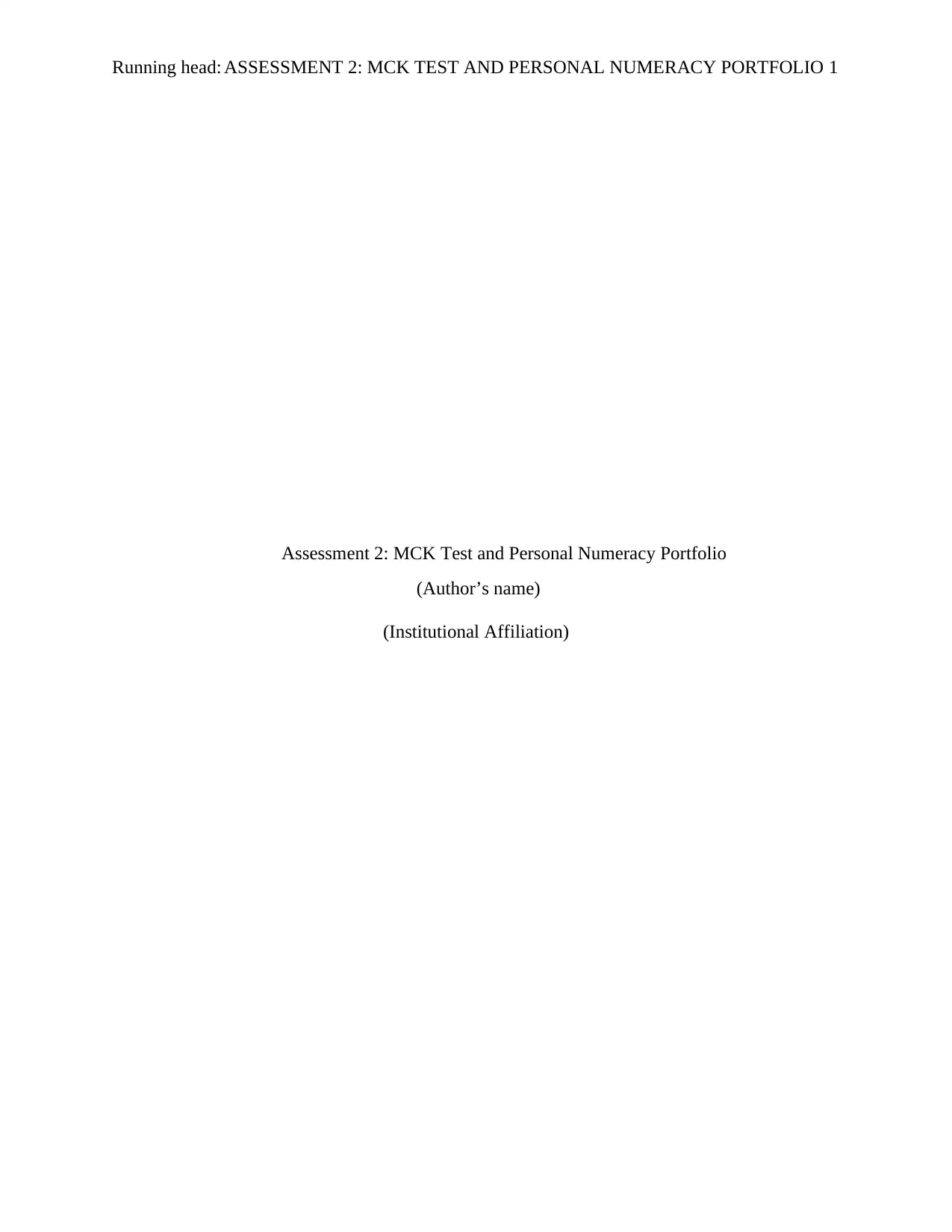
Running head: ASSESSMENT 2: MCK TEST AND PERSONAL NUMERACY PORTFOLIO 1
Assessment 2: MCK Test and Personal Numeracy Portfolio
(Author’s name)
(Institutional Affiliation)
Assessment 2: MCK Test and Personal Numeracy Portfolio
(Author’s name)
(Institutional Affiliation)
Paraphrase This Document
Need a fresh take? Get an instant paraphrase of this document with our AI Paraphraser
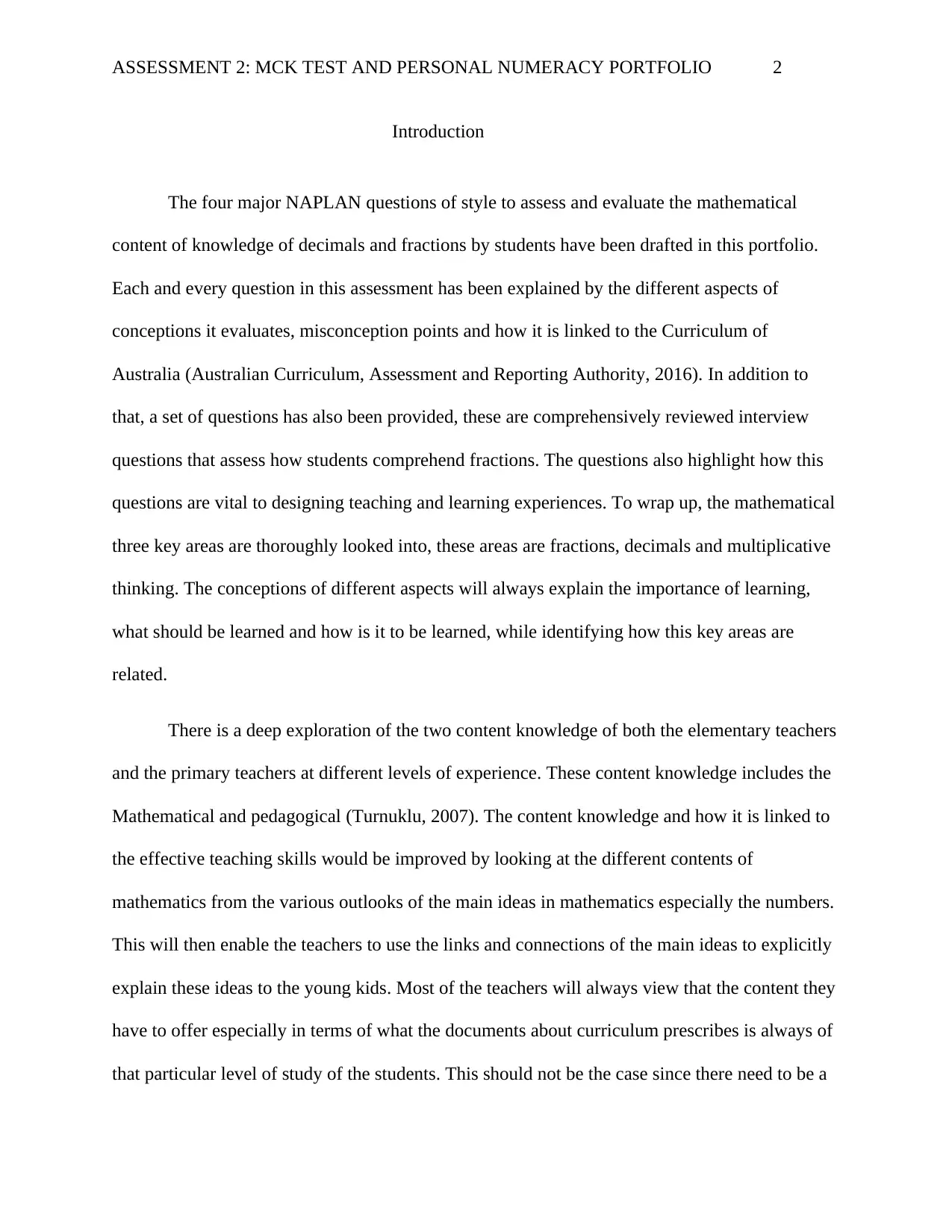
ASSESSMENT 2: MCK TEST AND PERSONAL NUMERACY PORTFOLIO 2
Introduction
The four major NAPLAN questions of style to assess and evaluate the mathematical
content of knowledge of decimals and fractions by students have been drafted in this portfolio.
Each and every question in this assessment has been explained by the different aspects of
conceptions it evaluates, misconception points and how it is linked to the Curriculum of
Australia (Australian Curriculum, Assessment and Reporting Authority, 2016). In addition to
that, a set of questions has also been provided, these are comprehensively reviewed interview
questions that assess how students comprehend fractions. The questions also highlight how this
questions are vital to designing teaching and learning experiences. To wrap up, the mathematical
three key areas are thoroughly looked into, these areas are fractions, decimals and multiplicative
thinking. The conceptions of different aspects will always explain the importance of learning,
what should be learned and how is it to be learned, while identifying how this key areas are
related.
There is a deep exploration of the two content knowledge of both the elementary teachers
and the primary teachers at different levels of experience. These content knowledge includes the
Mathematical and pedagogical (Turnuklu, 2007). The content knowledge and how it is linked to
the effective teaching skills would be improved by looking at the different contents of
mathematics from the various outlooks of the main ideas in mathematics especially the numbers.
This will then enable the teachers to use the links and connections of the main ideas to explicitly
explain these ideas to the young kids. Most of the teachers will always view that the content they
have to offer especially in terms of what the documents about curriculum prescribes is always of
that particular level of study of the students. This should not be the case since there need to be a
Introduction
The four major NAPLAN questions of style to assess and evaluate the mathematical
content of knowledge of decimals and fractions by students have been drafted in this portfolio.
Each and every question in this assessment has been explained by the different aspects of
conceptions it evaluates, misconception points and how it is linked to the Curriculum of
Australia (Australian Curriculum, Assessment and Reporting Authority, 2016). In addition to
that, a set of questions has also been provided, these are comprehensively reviewed interview
questions that assess how students comprehend fractions. The questions also highlight how this
questions are vital to designing teaching and learning experiences. To wrap up, the mathematical
three key areas are thoroughly looked into, these areas are fractions, decimals and multiplicative
thinking. The conceptions of different aspects will always explain the importance of learning,
what should be learned and how is it to be learned, while identifying how this key areas are
related.
There is a deep exploration of the two content knowledge of both the elementary teachers
and the primary teachers at different levels of experience. These content knowledge includes the
Mathematical and pedagogical (Turnuklu, 2007). The content knowledge and how it is linked to
the effective teaching skills would be improved by looking at the different contents of
mathematics from the various outlooks of the main ideas in mathematics especially the numbers.
This will then enable the teachers to use the links and connections of the main ideas to explicitly
explain these ideas to the young kids. Most of the teachers will always view that the content they
have to offer especially in terms of what the documents about curriculum prescribes is always of
that particular level of study of the students. This should not be the case since there need to be a
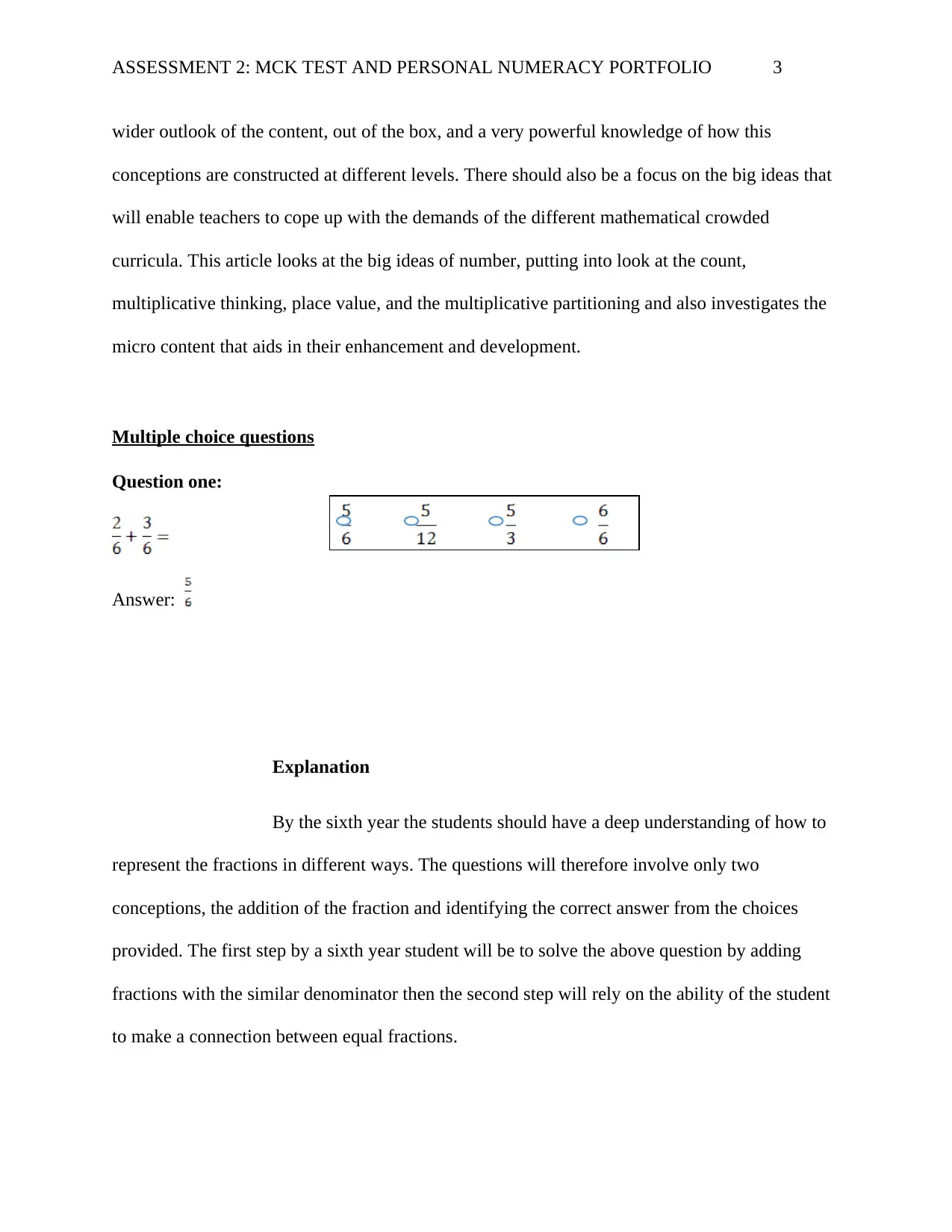
ASSESSMENT 2: MCK TEST AND PERSONAL NUMERACY PORTFOLIO 3
wider outlook of the content, out of the box, and a very powerful knowledge of how this
conceptions are constructed at different levels. There should also be a focus on the big ideas that
will enable teachers to cope up with the demands of the different mathematical crowded
curricula. This article looks at the big ideas of number, putting into look at the count,
multiplicative thinking, place value, and the multiplicative partitioning and also investigates the
micro content that aids in their enhancement and development.
Multiple choice questions
Question one:
Answer:
Explanation
By the sixth year the students should have a deep understanding of how to
represent the fractions in different ways. The questions will therefore involve only two
conceptions, the addition of the fraction and identifying the correct answer from the choices
provided. The first step by a sixth year student will be to solve the above question by adding
fractions with the similar denominator then the second step will rely on the ability of the student
to make a connection between equal fractions.
wider outlook of the content, out of the box, and a very powerful knowledge of how this
conceptions are constructed at different levels. There should also be a focus on the big ideas that
will enable teachers to cope up with the demands of the different mathematical crowded
curricula. This article looks at the big ideas of number, putting into look at the count,
multiplicative thinking, place value, and the multiplicative partitioning and also investigates the
micro content that aids in their enhancement and development.
Multiple choice questions
Question one:
Answer:
Explanation
By the sixth year the students should have a deep understanding of how to
represent the fractions in different ways. The questions will therefore involve only two
conceptions, the addition of the fraction and identifying the correct answer from the choices
provided. The first step by a sixth year student will be to solve the above question by adding
fractions with the similar denominator then the second step will rely on the ability of the student
to make a connection between equal fractions.
⊘ This is a preview!⊘
Do you want full access?
Subscribe today to unlock all pages.

Trusted by 1+ million students worldwide
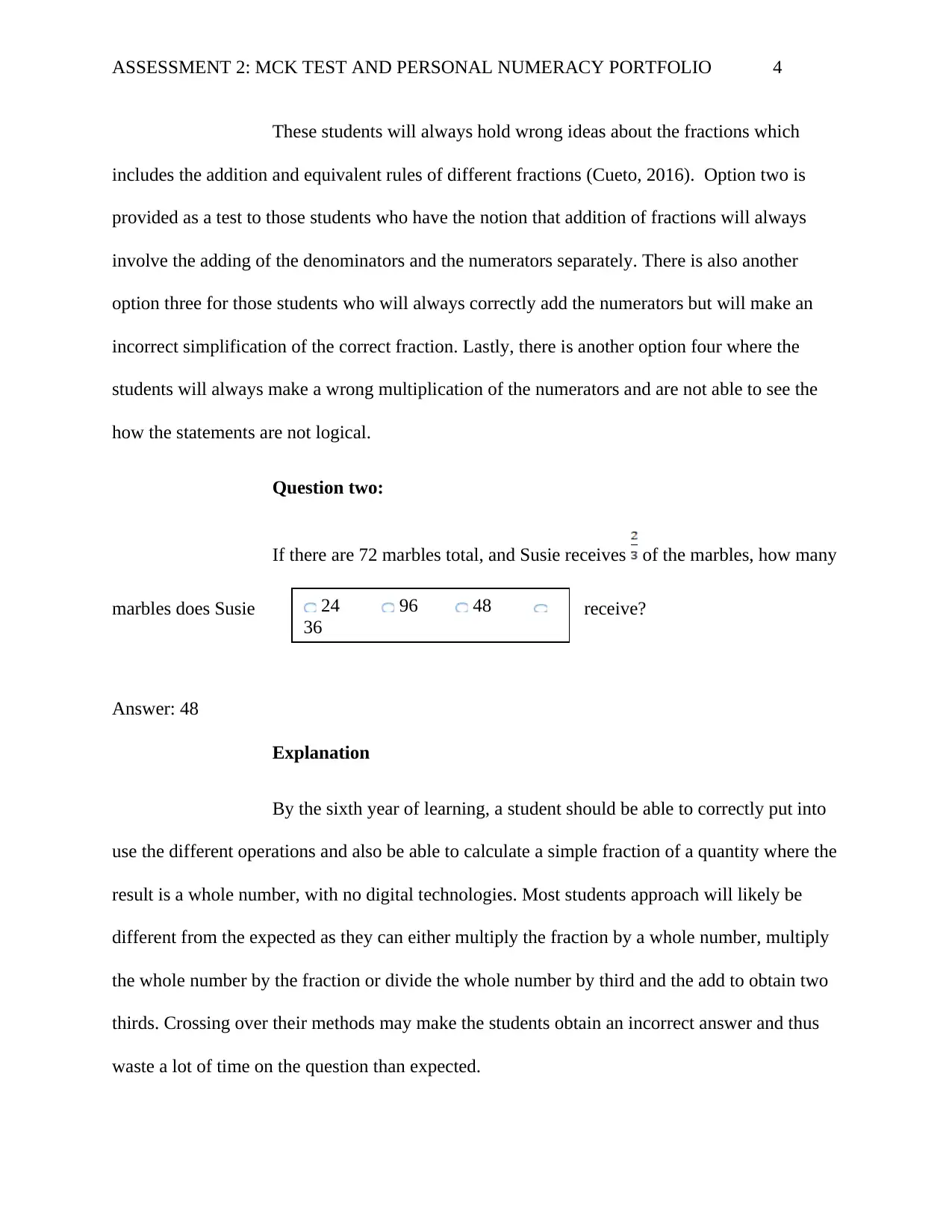
ASSESSMENT 2: MCK TEST AND PERSONAL NUMERACY PORTFOLIO 4
These students will always hold wrong ideas about the fractions which
includes the addition and equivalent rules of different fractions (Cueto, 2016). Option two is
provided as a test to those students who have the notion that addition of fractions will always
involve the adding of the denominators and the numerators separately. There is also another
option three for those students who will always correctly add the numerators but will make an
incorrect simplification of the correct fraction. Lastly, there is another option four where the
students will always make a wrong multiplication of the numerators and are not able to see the
how the statements are not logical.
Question two:
If there are 72 marbles total, and Susie receives of the marbles, how many
marbles does Susie receive?
Answer: 48
Explanation
By the sixth year of learning, a student should be able to correctly put into
use the different operations and also be able to calculate a simple fraction of a quantity where the
result is a whole number, with no digital technologies. Most students approach will likely be
different from the expected as they can either multiply the fraction by a whole number, multiply
the whole number by the fraction or divide the whole number by third and the add to obtain two
thirds. Crossing over their methods may make the students obtain an incorrect answer and thus
waste a lot of time on the question than expected.
24 96 48
36
These students will always hold wrong ideas about the fractions which
includes the addition and equivalent rules of different fractions (Cueto, 2016). Option two is
provided as a test to those students who have the notion that addition of fractions will always
involve the adding of the denominators and the numerators separately. There is also another
option three for those students who will always correctly add the numerators but will make an
incorrect simplification of the correct fraction. Lastly, there is another option four where the
students will always make a wrong multiplication of the numerators and are not able to see the
how the statements are not logical.
Question two:
If there are 72 marbles total, and Susie receives of the marbles, how many
marbles does Susie receive?
Answer: 48
Explanation
By the sixth year of learning, a student should be able to correctly put into
use the different operations and also be able to calculate a simple fraction of a quantity where the
result is a whole number, with no digital technologies. Most students approach will likely be
different from the expected as they can either multiply the fraction by a whole number, multiply
the whole number by the fraction or divide the whole number by third and the add to obtain two
thirds. Crossing over their methods may make the students obtain an incorrect answer and thus
waste a lot of time on the question than expected.
24 96 48
36
Paraphrase This Document
Need a fresh take? Get an instant paraphrase of this document with our AI Paraphraser
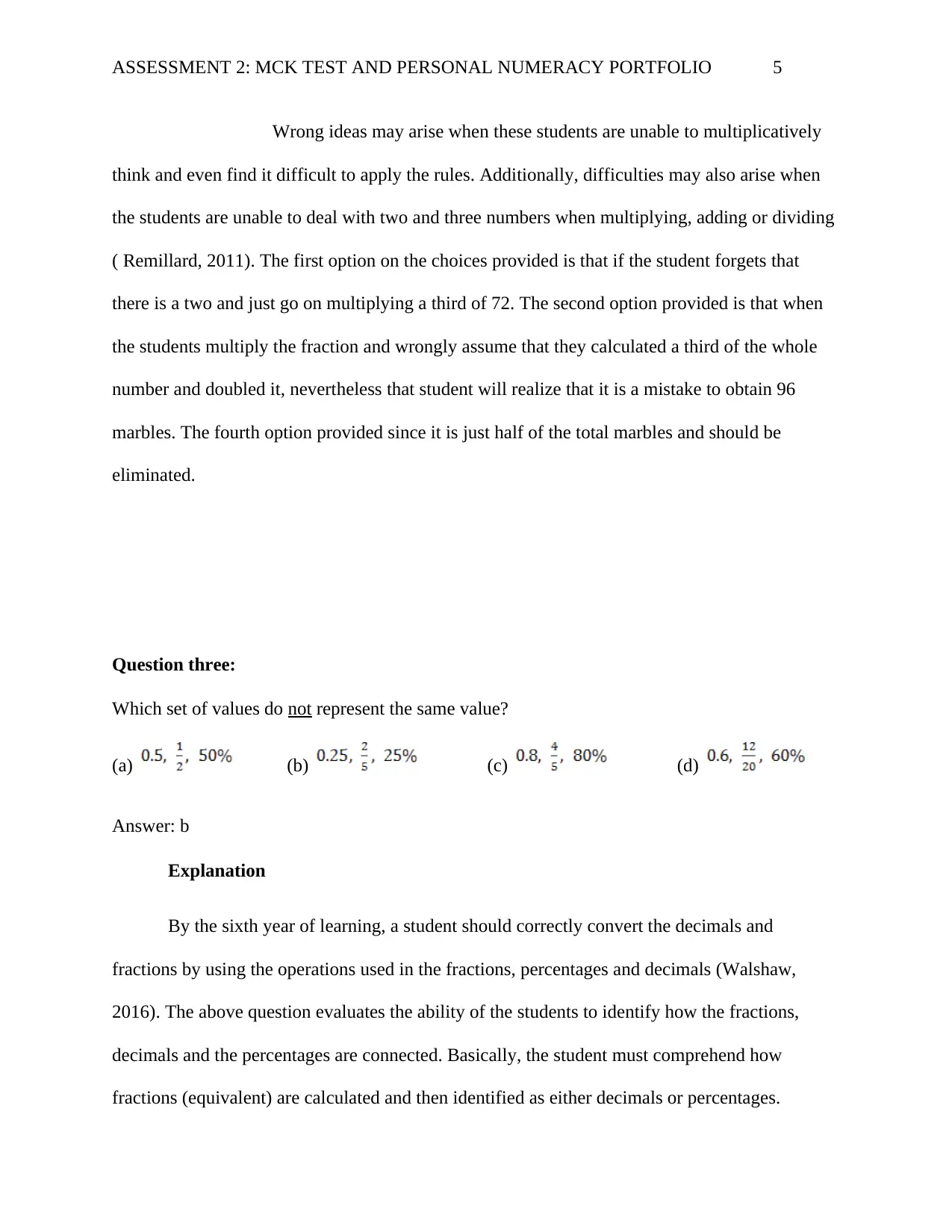
ASSESSMENT 2: MCK TEST AND PERSONAL NUMERACY PORTFOLIO 5
Wrong ideas may arise when these students are unable to multiplicatively
think and even find it difficult to apply the rules. Additionally, difficulties may also arise when
the students are unable to deal with two and three numbers when multiplying, adding or dividing
( Remillard, 2011). The first option on the choices provided is that if the student forgets that
there is a two and just go on multiplying a third of 72. The second option provided is that when
the students multiply the fraction and wrongly assume that they calculated a third of the whole
number and doubled it, nevertheless that student will realize that it is a mistake to obtain 96
marbles. The fourth option provided since it is just half of the total marbles and should be
eliminated.
Question three:
Which set of values do not represent the same value?
(a) (b) (c) (d)
Answer: b
Explanation
By the sixth year of learning, a student should correctly convert the decimals and
fractions by using the operations used in the fractions, percentages and decimals (Walshaw,
2016). The above question evaluates the ability of the students to identify how the fractions,
decimals and the percentages are connected. Basically, the student must comprehend how
fractions (equivalent) are calculated and then identified as either decimals or percentages.
Wrong ideas may arise when these students are unable to multiplicatively
think and even find it difficult to apply the rules. Additionally, difficulties may also arise when
the students are unable to deal with two and three numbers when multiplying, adding or dividing
( Remillard, 2011). The first option on the choices provided is that if the student forgets that
there is a two and just go on multiplying a third of 72. The second option provided is that when
the students multiply the fraction and wrongly assume that they calculated a third of the whole
number and doubled it, nevertheless that student will realize that it is a mistake to obtain 96
marbles. The fourth option provided since it is just half of the total marbles and should be
eliminated.
Question three:
Which set of values do not represent the same value?
(a) (b) (c) (d)
Answer: b
Explanation
By the sixth year of learning, a student should correctly convert the decimals and
fractions by using the operations used in the fractions, percentages and decimals (Walshaw,
2016). The above question evaluates the ability of the students to identify how the fractions,
decimals and the percentages are connected. Basically, the student must comprehend how
fractions (equivalent) are calculated and then identified as either decimals or percentages.
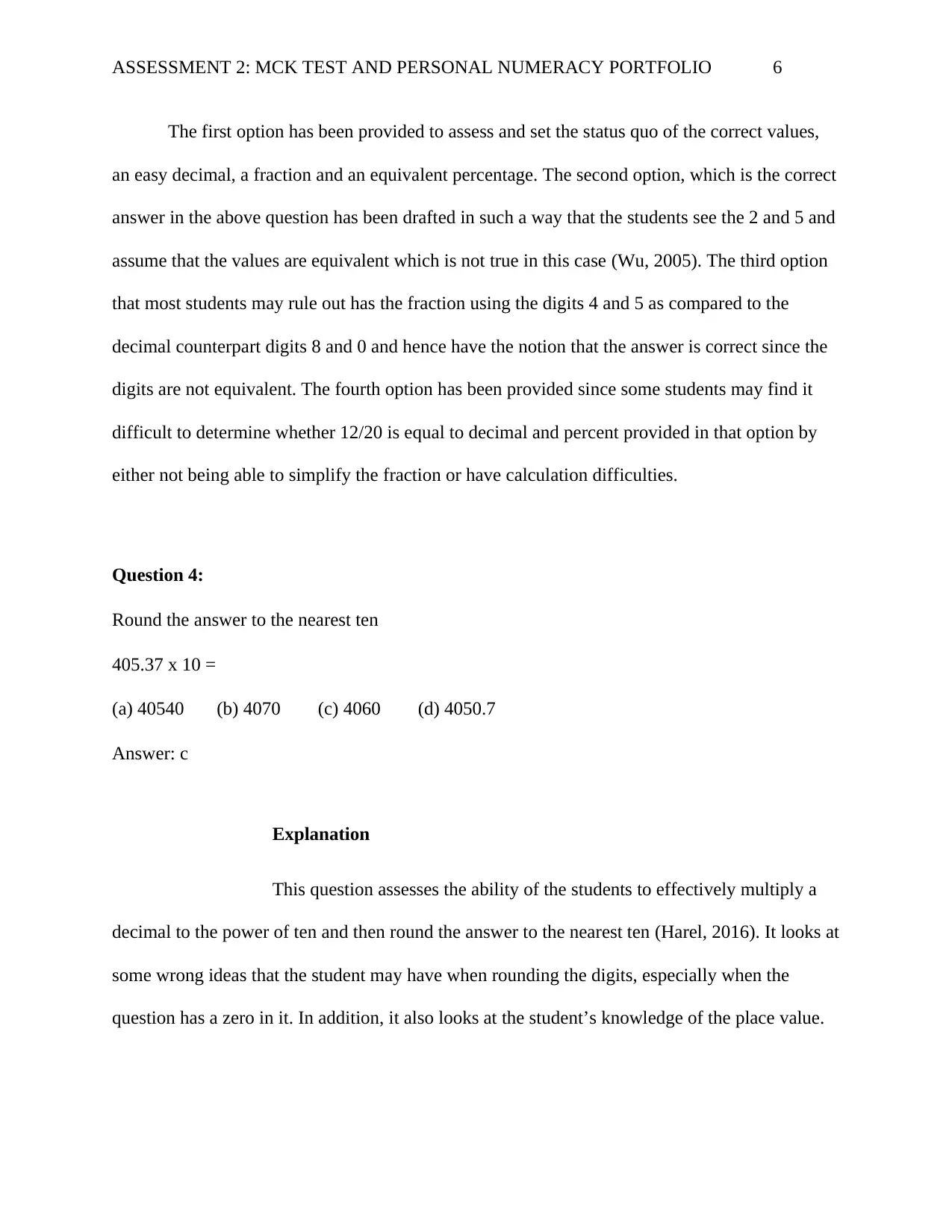
ASSESSMENT 2: MCK TEST AND PERSONAL NUMERACY PORTFOLIO 6
The first option has been provided to assess and set the status quo of the correct values,
an easy decimal, a fraction and an equivalent percentage. The second option, which is the correct
answer in the above question has been drafted in such a way that the students see the 2 and 5 and
assume that the values are equivalent which is not true in this case (Wu, 2005). The third option
that most students may rule out has the fraction using the digits 4 and 5 as compared to the
decimal counterpart digits 8 and 0 and hence have the notion that the answer is correct since the
digits are not equivalent. The fourth option has been provided since some students may find it
difficult to determine whether 12/20 is equal to decimal and percent provided in that option by
either not being able to simplify the fraction or have calculation difficulties.
Question 4:
Round the answer to the nearest ten
405.37 x 10 =
(a) 40540 (b) 4070 (c) 4060 (d) 4050.7
Answer: c
Explanation
This question assesses the ability of the students to effectively multiply a
decimal to the power of ten and then round the answer to the nearest ten (Harel, 2016). It looks at
some wrong ideas that the student may have when rounding the digits, especially when the
question has a zero in it. In addition, it also looks at the student’s knowledge of the place value.
The first option has been provided to assess and set the status quo of the correct values,
an easy decimal, a fraction and an equivalent percentage. The second option, which is the correct
answer in the above question has been drafted in such a way that the students see the 2 and 5 and
assume that the values are equivalent which is not true in this case (Wu, 2005). The third option
that most students may rule out has the fraction using the digits 4 and 5 as compared to the
decimal counterpart digits 8 and 0 and hence have the notion that the answer is correct since the
digits are not equivalent. The fourth option has been provided since some students may find it
difficult to determine whether 12/20 is equal to decimal and percent provided in that option by
either not being able to simplify the fraction or have calculation difficulties.
Question 4:
Round the answer to the nearest ten
405.37 x 10 =
(a) 40540 (b) 4070 (c) 4060 (d) 4050.7
Answer: c
Explanation
This question assesses the ability of the students to effectively multiply a
decimal to the power of ten and then round the answer to the nearest ten (Harel, 2016). It looks at
some wrong ideas that the student may have when rounding the digits, especially when the
question has a zero in it. In addition, it also looks at the student’s knowledge of the place value.
⊘ This is a preview!⊘
Do you want full access?
Subscribe today to unlock all pages.

Trusted by 1+ million students worldwide
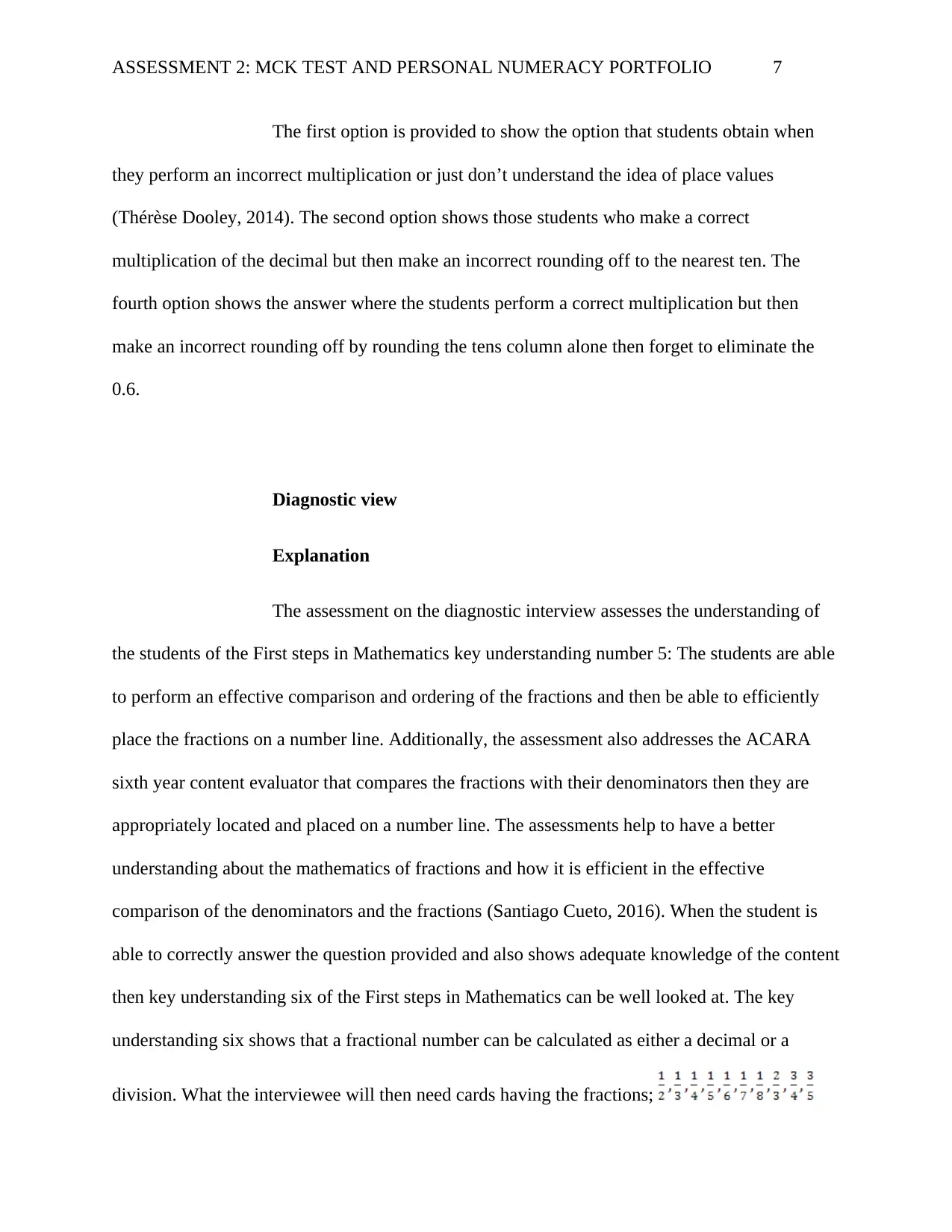
ASSESSMENT 2: MCK TEST AND PERSONAL NUMERACY PORTFOLIO 7
The first option is provided to show the option that students obtain when
they perform an incorrect multiplication or just don’t understand the idea of place values
(Thérèse Dooley, 2014). The second option shows those students who make a correct
multiplication of the decimal but then make an incorrect rounding off to the nearest ten. The
fourth option shows the answer where the students perform a correct multiplication but then
make an incorrect rounding off by rounding the tens column alone then forget to eliminate the
0.6.
Diagnostic view
Explanation
The assessment on the diagnostic interview assesses the understanding of
the students of the First steps in Mathematics key understanding number 5: The students are able
to perform an effective comparison and ordering of the fractions and then be able to efficiently
place the fractions on a number line. Additionally, the assessment also addresses the ACARA
sixth year content evaluator that compares the fractions with their denominators then they are
appropriately located and placed on a number line. The assessments help to have a better
understanding about the mathematics of fractions and how it is efficient in the effective
comparison of the denominators and the fractions (Santiago Cueto, 2016). When the student is
able to correctly answer the question provided and also shows adequate knowledge of the content
then key understanding six of the First steps in Mathematics can be well looked at. The key
understanding six shows that a fractional number can be calculated as either a decimal or a
division. What the interviewee will then need cards having the fractions;
The first option is provided to show the option that students obtain when
they perform an incorrect multiplication or just don’t understand the idea of place values
(Thérèse Dooley, 2014). The second option shows those students who make a correct
multiplication of the decimal but then make an incorrect rounding off to the nearest ten. The
fourth option shows the answer where the students perform a correct multiplication but then
make an incorrect rounding off by rounding the tens column alone then forget to eliminate the
0.6.
Diagnostic view
Explanation
The assessment on the diagnostic interview assesses the understanding of
the students of the First steps in Mathematics key understanding number 5: The students are able
to perform an effective comparison and ordering of the fractions and then be able to efficiently
place the fractions on a number line. Additionally, the assessment also addresses the ACARA
sixth year content evaluator that compares the fractions with their denominators then they are
appropriately located and placed on a number line. The assessments help to have a better
understanding about the mathematics of fractions and how it is efficient in the effective
comparison of the denominators and the fractions (Santiago Cueto, 2016). When the student is
able to correctly answer the question provided and also shows adequate knowledge of the content
then key understanding six of the First steps in Mathematics can be well looked at. The key
understanding six shows that a fractional number can be calculated as either a decimal or a
division. What the interviewee will then need cards having the fractions;
Paraphrase This Document
Need a fresh take? Get an instant paraphrase of this document with our AI Paraphraser
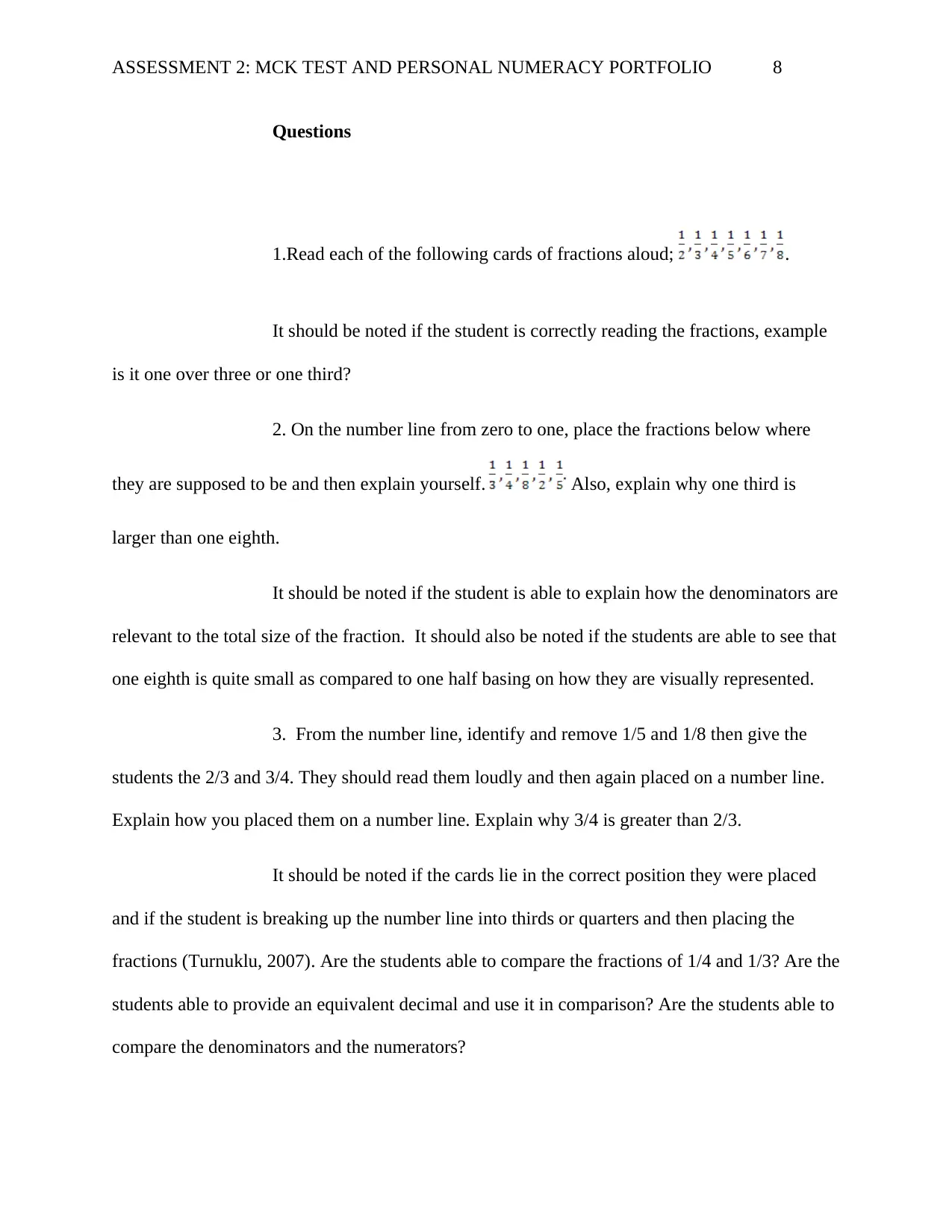
ASSESSMENT 2: MCK TEST AND PERSONAL NUMERACY PORTFOLIO 8
Questions
1.Read each of the following cards of fractions aloud; .
It should be noted if the student is correctly reading the fractions, example
is it one over three or one third?
2. On the number line from zero to one, place the fractions below where
they are supposed to be and then explain yourself. Also, explain why one third is
larger than one eighth.
It should be noted if the student is able to explain how the denominators are
relevant to the total size of the fraction. It should also be noted if the students are able to see that
one eighth is quite small as compared to one half basing on how they are visually represented.
3. From the number line, identify and remove 1/5 and 1/8 then give the
students the 2/3 and 3/4. They should read them loudly and then again placed on a number line.
Explain how you placed them on a number line. Explain why 3/4 is greater than 2/3.
It should be noted if the cards lie in the correct position they were placed
and if the student is breaking up the number line into thirds or quarters and then placing the
fractions (Turnuklu, 2007). Are the students able to compare the fractions of 1/4 and 1/3? Are the
students able to provide an equivalent decimal and use it in comparison? Are the students able to
compare the denominators and the numerators?
Questions
1.Read each of the following cards of fractions aloud; .
It should be noted if the student is correctly reading the fractions, example
is it one over three or one third?
2. On the number line from zero to one, place the fractions below where
they are supposed to be and then explain yourself. Also, explain why one third is
larger than one eighth.
It should be noted if the student is able to explain how the denominators are
relevant to the total size of the fraction. It should also be noted if the students are able to see that
one eighth is quite small as compared to one half basing on how they are visually represented.
3. From the number line, identify and remove 1/5 and 1/8 then give the
students the 2/3 and 3/4. They should read them loudly and then again placed on a number line.
Explain how you placed them on a number line. Explain why 3/4 is greater than 2/3.
It should be noted if the cards lie in the correct position they were placed
and if the student is breaking up the number line into thirds or quarters and then placing the
fractions (Turnuklu, 2007). Are the students able to compare the fractions of 1/4 and 1/3? Are the
students able to provide an equivalent decimal and use it in comparison? Are the students able to
compare the denominators and the numerators?
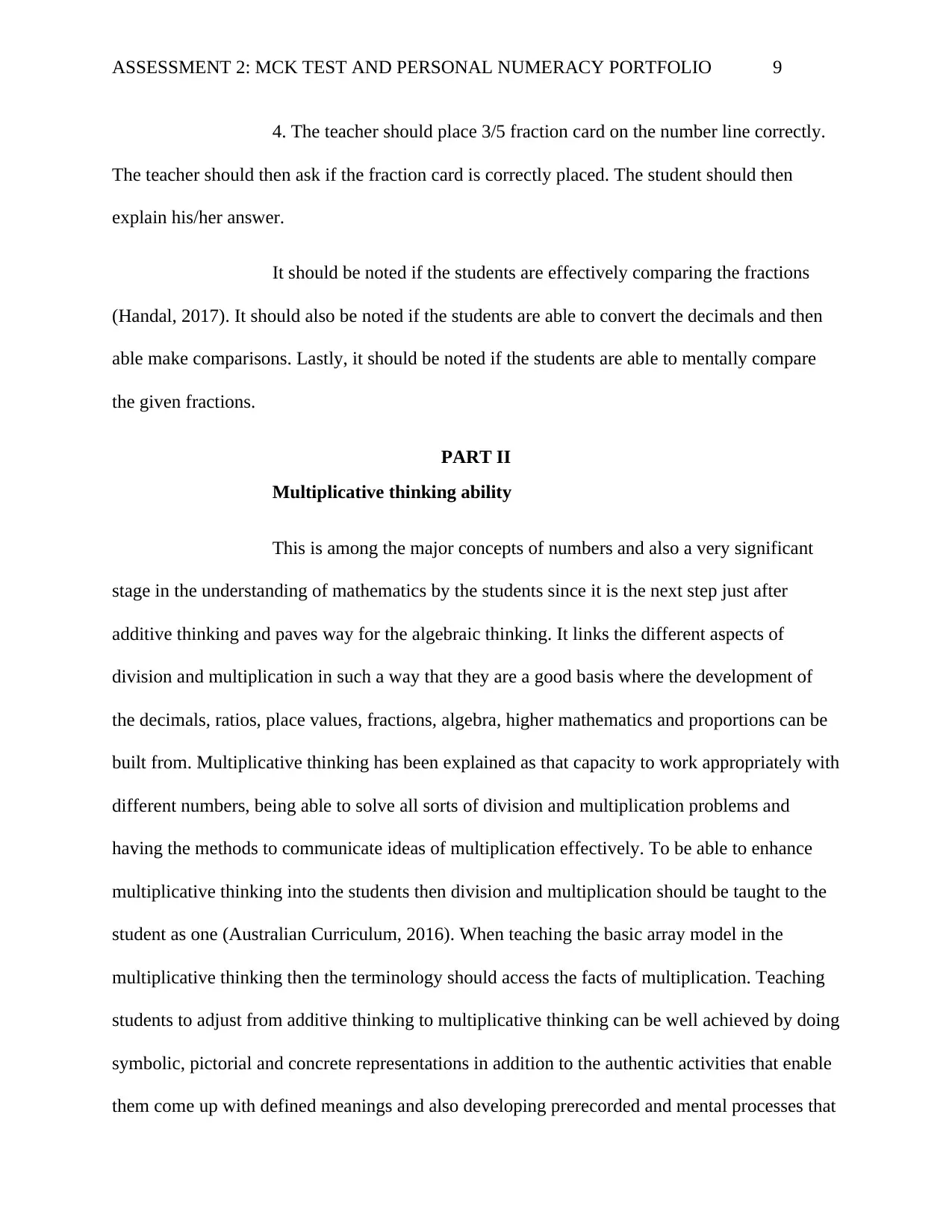
ASSESSMENT 2: MCK TEST AND PERSONAL NUMERACY PORTFOLIO 9
4. The teacher should place 3/5 fraction card on the number line correctly.
The teacher should then ask if the fraction card is correctly placed. The student should then
explain his/her answer.
It should be noted if the students are effectively comparing the fractions
(Handal, 2017). It should also be noted if the students are able to convert the decimals and then
able make comparisons. Lastly, it should be noted if the students are able to mentally compare
the given fractions.
PART II
Multiplicative thinking ability
This is among the major concepts of numbers and also a very significant
stage in the understanding of mathematics by the students since it is the next step just after
additive thinking and paves way for the algebraic thinking. It links the different aspects of
division and multiplication in such a way that they are a good basis where the development of
the decimals, ratios, place values, fractions, algebra, higher mathematics and proportions can be
built from. Multiplicative thinking has been explained as that capacity to work appropriately with
different numbers, being able to solve all sorts of division and multiplication problems and
having the methods to communicate ideas of multiplication effectively. To be able to enhance
multiplicative thinking into the students then division and multiplication should be taught to the
student as one (Australian Curriculum, 2016). When teaching the basic array model in the
multiplicative thinking then the terminology should access the facts of multiplication. Teaching
students to adjust from additive thinking to multiplicative thinking can be well achieved by doing
symbolic, pictorial and concrete representations in addition to the authentic activities that enable
them come up with defined meanings and also developing prerecorded and mental processes that
4. The teacher should place 3/5 fraction card on the number line correctly.
The teacher should then ask if the fraction card is correctly placed. The student should then
explain his/her answer.
It should be noted if the students are effectively comparing the fractions
(Handal, 2017). It should also be noted if the students are able to convert the decimals and then
able make comparisons. Lastly, it should be noted if the students are able to mentally compare
the given fractions.
PART II
Multiplicative thinking ability
This is among the major concepts of numbers and also a very significant
stage in the understanding of mathematics by the students since it is the next step just after
additive thinking and paves way for the algebraic thinking. It links the different aspects of
division and multiplication in such a way that they are a good basis where the development of
the decimals, ratios, place values, fractions, algebra, higher mathematics and proportions can be
built from. Multiplicative thinking has been explained as that capacity to work appropriately with
different numbers, being able to solve all sorts of division and multiplication problems and
having the methods to communicate ideas of multiplication effectively. To be able to enhance
multiplicative thinking into the students then division and multiplication should be taught to the
student as one (Australian Curriculum, 2016). When teaching the basic array model in the
multiplicative thinking then the terminology should access the facts of multiplication. Teaching
students to adjust from additive thinking to multiplicative thinking can be well achieved by doing
symbolic, pictorial and concrete representations in addition to the authentic activities that enable
them come up with defined meanings and also developing prerecorded and mental processes that
⊘ This is a preview!⊘
Do you want full access?
Subscribe today to unlock all pages.

Trusted by 1+ million students worldwide

ASSESSMENT 2: MCK TEST AND PERSONAL NUMERACY PORTFOLIO 10
entails the ten base system. It is good to note that it is also the responsibility of the teacher to
give effective and appropriate opportunities that will enable the students increase their thinking
multiplicatively and also comprehend those factors that support mathematics and will be
experienced in further studies.
The vitality of adjusting from thinking additively to multiplicatively is that
those students not well good at the multiplicative thinking don’t have the basic skills and
knowledge essentially in performing school mathematics. For instance, an equation with the
following properties 2x3, an additive thinker will take it as 2+2+2, which is quite intricate to the
studies of such a student when bigger values are provided. The students need to understand that
multiplication is not repeated addition but rather it is of more put a quantity into scaling. 2x3 is
just three groups of two (Walshaw, 2013). To a more beneficial manner the additive thinking
will play a role of self-sacrificial when the property of distribution of multiplicative thinkers is
used in arrays, for example 8 eights can be viewed as 3 eights and 5 eights, and when scaling of
the numbers is done then additive thinking will be used in quick calculations. However, it is
important to note that this adjustment will take several years, since there need to be introduction
and evaluation of the ideas which cannot be entirely understood during the initial years but just
until the students are into their teen ages. It is therefore very crucial that the elements and
properties of multiplicative thinking be enhanced early enough and a thorough research done.
There is always an agreement among different people on the understanding
that is needed to enhance the development of thinking multiplicatively, this requires a new
approach in the teaching and learning of both division and multiplication at school, appropriate
use of the arrays in the studies, particular approach to terminologies and also more than adequate
knowledge of the basic facts of multiplication. First and foremost, to enhance the skills of
entails the ten base system. It is good to note that it is also the responsibility of the teacher to
give effective and appropriate opportunities that will enable the students increase their thinking
multiplicatively and also comprehend those factors that support mathematics and will be
experienced in further studies.
The vitality of adjusting from thinking additively to multiplicatively is that
those students not well good at the multiplicative thinking don’t have the basic skills and
knowledge essentially in performing school mathematics. For instance, an equation with the
following properties 2x3, an additive thinker will take it as 2+2+2, which is quite intricate to the
studies of such a student when bigger values are provided. The students need to understand that
multiplication is not repeated addition but rather it is of more put a quantity into scaling. 2x3 is
just three groups of two (Walshaw, 2013). To a more beneficial manner the additive thinking
will play a role of self-sacrificial when the property of distribution of multiplicative thinkers is
used in arrays, for example 8 eights can be viewed as 3 eights and 5 eights, and when scaling of
the numbers is done then additive thinking will be used in quick calculations. However, it is
important to note that this adjustment will take several years, since there need to be introduction
and evaluation of the ideas which cannot be entirely understood during the initial years but just
until the students are into their teen ages. It is therefore very crucial that the elements and
properties of multiplicative thinking be enhanced early enough and a thorough research done.
There is always an agreement among different people on the understanding
that is needed to enhance the development of thinking multiplicatively, this requires a new
approach in the teaching and learning of both division and multiplication at school, appropriate
use of the arrays in the studies, particular approach to terminologies and also more than adequate
knowledge of the basic facts of multiplication. First and foremost, to enhance the skills of
Paraphrase This Document
Need a fresh take? Get an instant paraphrase of this document with our AI Paraphraser

ASSESSMENT 2: MCK TEST AND PERSONAL NUMERACY PORTFOLIO 11
multiplicative thinkers then both division and multiplication should be integrated and then taught
as one a concept called the situation of multiplication (Harel, 2016). The importance of teaching
this concept is that it focuses on both the above terms (multiplication and division) by looking at
three different quantities namely; the size of equal groups, size of each group and the total
amount. In a more practical way, if one of the quantity is not known then the other known
quantities will either be multiplied or divided in order to obtain the unknown quantity, this is a
key conception that is always used in the mathematical algebra. Secondly, there are three
quantities encompassed in an array in this concept of multiplicative situation and are very crucial
in the enhancement of the skills of multiplicative thinkers, and hence these arrays must be
introduced through tangible division and multiplicative situations (Dooley, 2014). For instance,
if Bruce has 3 bags of 5 oranges, what is the total number of oranges he has? This is a very great
way of visually representing the three quantities in question. The problem above can be
symbolically represented as 3x5 and this linked to an array, which will help complete and depict
the pictorial, symbolic and concrete model of a teaching termed as constructivist. All this arrays
allows the students to develop a more extensive and pliable comprehension of the multiplicative
situation and also to fully acknowledge the two-dimensional way of the process in multiplication.
Emphasizing of the particular terminologies relating to arrays also have an impact on the gaining
of the multiplicative thinking. This specifically factors will include; multiple or product. The
language in use will enforce the relationship between division and multiplication and should be
introduced early enough during array introduction to help adjust from additive thinking. To
ensure maximum efficiency, this language should be aided by large use of things that will
necessitate the students learning not through procedures but from standard concepts (Turnuklu,
2007). Finally, it has also been suggested that automatically accessing the facts of multiplication
multiplicative thinkers then both division and multiplication should be integrated and then taught
as one a concept called the situation of multiplication (Harel, 2016). The importance of teaching
this concept is that it focuses on both the above terms (multiplication and division) by looking at
three different quantities namely; the size of equal groups, size of each group and the total
amount. In a more practical way, if one of the quantity is not known then the other known
quantities will either be multiplied or divided in order to obtain the unknown quantity, this is a
key conception that is always used in the mathematical algebra. Secondly, there are three
quantities encompassed in an array in this concept of multiplicative situation and are very crucial
in the enhancement of the skills of multiplicative thinkers, and hence these arrays must be
introduced through tangible division and multiplicative situations (Dooley, 2014). For instance,
if Bruce has 3 bags of 5 oranges, what is the total number of oranges he has? This is a very great
way of visually representing the three quantities in question. The problem above can be
symbolically represented as 3x5 and this linked to an array, which will help complete and depict
the pictorial, symbolic and concrete model of a teaching termed as constructivist. All this arrays
allows the students to develop a more extensive and pliable comprehension of the multiplicative
situation and also to fully acknowledge the two-dimensional way of the process in multiplication.
Emphasizing of the particular terminologies relating to arrays also have an impact on the gaining
of the multiplicative thinking. This specifically factors will include; multiple or product. The
language in use will enforce the relationship between division and multiplication and should be
introduced early enough during array introduction to help adjust from additive thinking. To
ensure maximum efficiency, this language should be aided by large use of things that will
necessitate the students learning not through procedures but from standard concepts (Turnuklu,
2007). Finally, it has also been suggested that automatically accessing the facts of multiplication
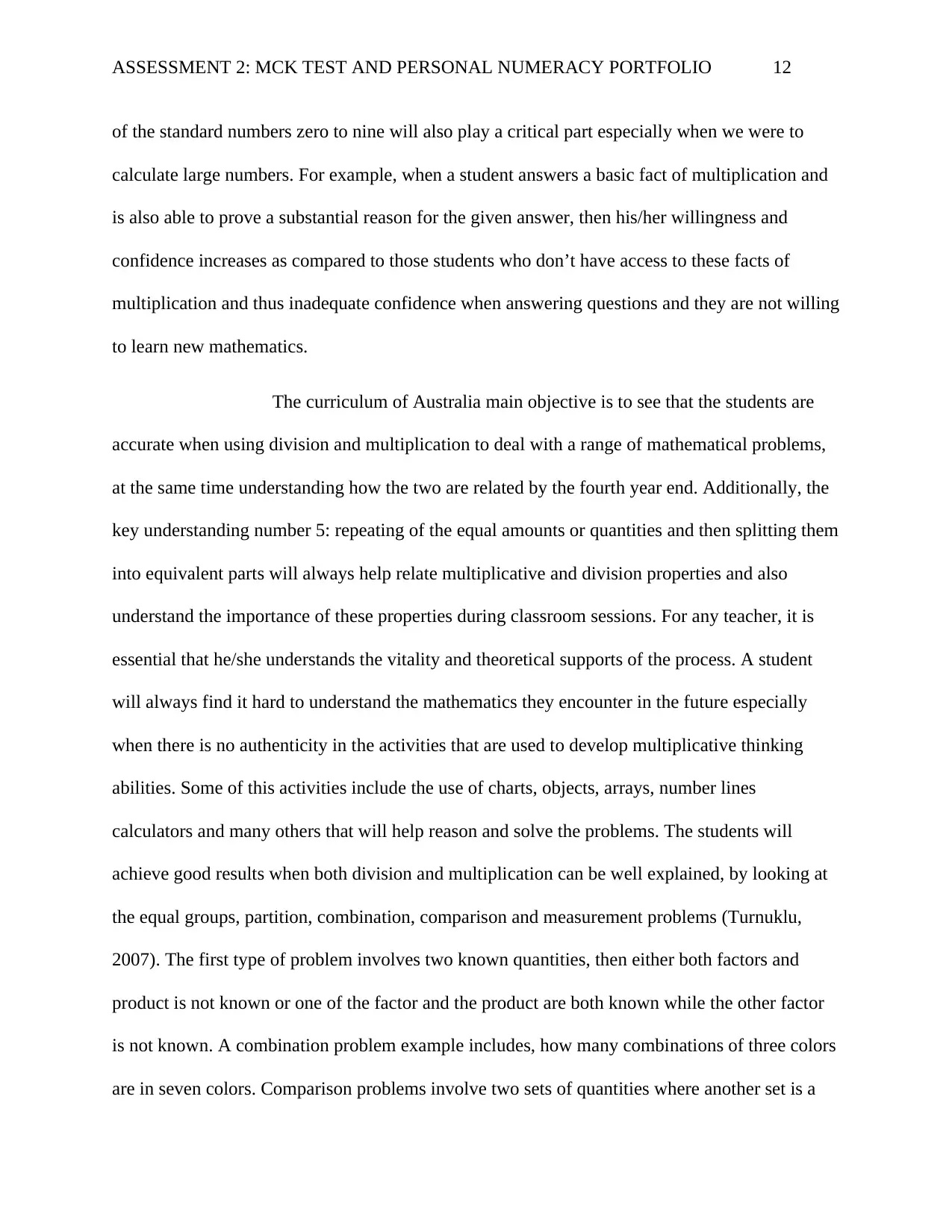
ASSESSMENT 2: MCK TEST AND PERSONAL NUMERACY PORTFOLIO 12
of the standard numbers zero to nine will also play a critical part especially when we were to
calculate large numbers. For example, when a student answers a basic fact of multiplication and
is also able to prove a substantial reason for the given answer, then his/her willingness and
confidence increases as compared to those students who don’t have access to these facts of
multiplication and thus inadequate confidence when answering questions and they are not willing
to learn new mathematics.
The curriculum of Australia main objective is to see that the students are
accurate when using division and multiplication to deal with a range of mathematical problems,
at the same time understanding how the two are related by the fourth year end. Additionally, the
key understanding number 5: repeating of the equal amounts or quantities and then splitting them
into equivalent parts will always help relate multiplicative and division properties and also
understand the importance of these properties during classroom sessions. For any teacher, it is
essential that he/she understands the vitality and theoretical supports of the process. A student
will always find it hard to understand the mathematics they encounter in the future especially
when there is no authenticity in the activities that are used to develop multiplicative thinking
abilities. Some of this activities include the use of charts, objects, arrays, number lines
calculators and many others that will help reason and solve the problems. The students will
achieve good results when both division and multiplication can be well explained, by looking at
the equal groups, partition, combination, comparison and measurement problems (Turnuklu,
2007). The first type of problem involves two known quantities, then either both factors and
product is not known or one of the factor and the product are both known while the other factor
is not known. A combination problem example includes, how many combinations of three colors
are in seven colors. Comparison problems involve two sets of quantities where another set is a
of the standard numbers zero to nine will also play a critical part especially when we were to
calculate large numbers. For example, when a student answers a basic fact of multiplication and
is also able to prove a substantial reason for the given answer, then his/her willingness and
confidence increases as compared to those students who don’t have access to these facts of
multiplication and thus inadequate confidence when answering questions and they are not willing
to learn new mathematics.
The curriculum of Australia main objective is to see that the students are
accurate when using division and multiplication to deal with a range of mathematical problems,
at the same time understanding how the two are related by the fourth year end. Additionally, the
key understanding number 5: repeating of the equal amounts or quantities and then splitting them
into equivalent parts will always help relate multiplicative and division properties and also
understand the importance of these properties during classroom sessions. For any teacher, it is
essential that he/she understands the vitality and theoretical supports of the process. A student
will always find it hard to understand the mathematics they encounter in the future especially
when there is no authenticity in the activities that are used to develop multiplicative thinking
abilities. Some of this activities include the use of charts, objects, arrays, number lines
calculators and many others that will help reason and solve the problems. The students will
achieve good results when both division and multiplication can be well explained, by looking at
the equal groups, partition, combination, comparison and measurement problems (Turnuklu,
2007). The first type of problem involves two known quantities, then either both factors and
product is not known or one of the factor and the product are both known while the other factor
is not known. A combination problem example includes, how many combinations of three colors
are in seven colors. Comparison problems involve two sets of quantities where another set is a
⊘ This is a preview!⊘
Do you want full access?
Subscribe today to unlock all pages.

Trusted by 1+ million students worldwide
1 out of 20
Related Documents
Your All-in-One AI-Powered Toolkit for Academic Success.
+13062052269
info@desklib.com
Available 24*7 on WhatsApp / Email
![[object Object]](/_next/static/media/star-bottom.7253800d.svg)
Unlock your academic potential
Copyright © 2020–2025 A2Z Services. All Rights Reserved. Developed and managed by ZUCOL.



